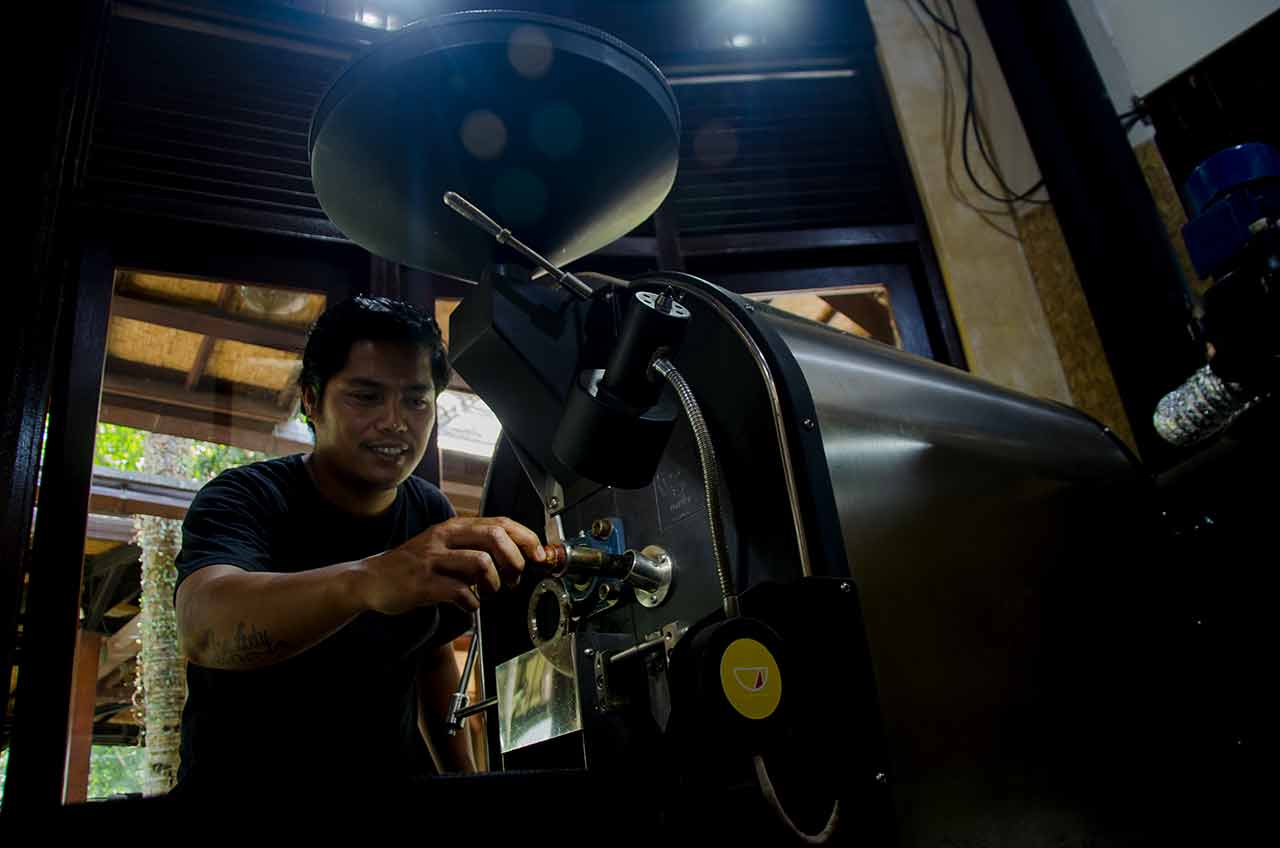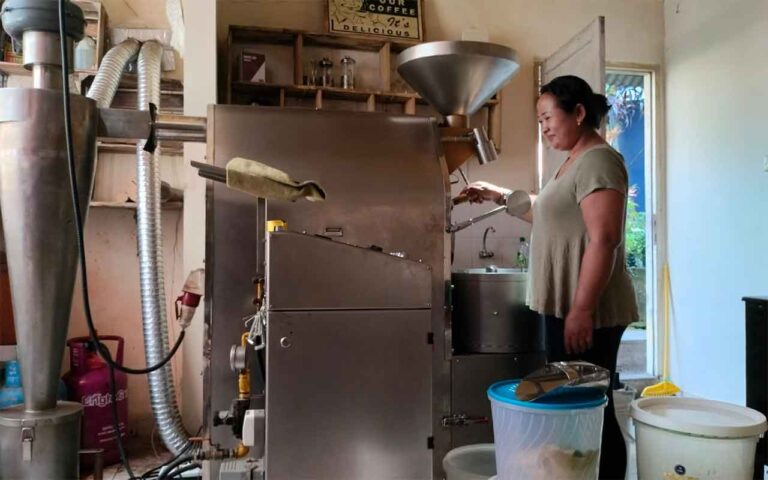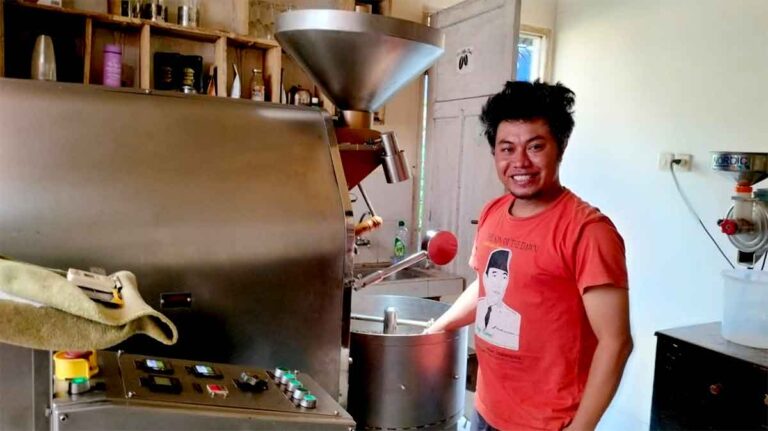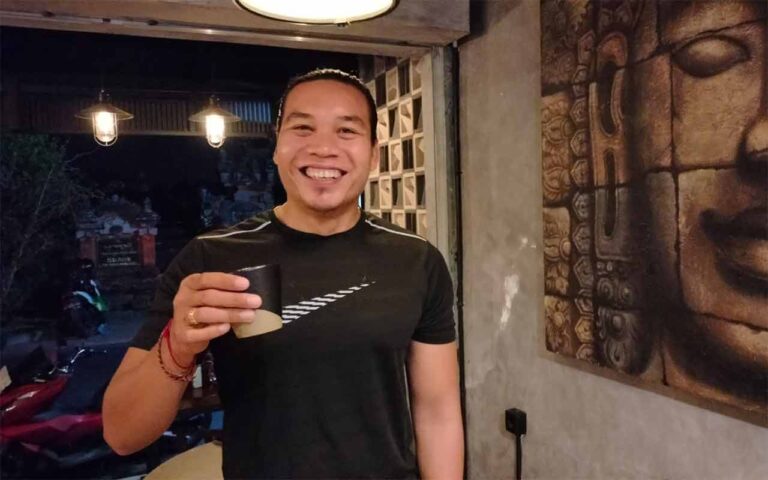The sound of the golden coffee beans rotating in the roasting tube was a subtle gurgle. These are green beans that have just entered from the feed port into the roasting tube barrel. Ida Bagus Gede Adiriawan, often called Gus Adi Kopi, a coffee roaster at Ubud Coffee Roastery (UCR), was busy working that morning.
Gus Adi observed the roasting process for the umpteenth round that morning, because the Froco roasting machine that was being operated had a maximum capacity of only 5 kg in one go.
Meanwhile, the fragrant aroma of coffee, which has just rolled from the cooling plate into the holding bucket, fills the roastery room. Gus Adi had started roasting coffee beans since 7 am that morning. I don’t know how much he has done before noon.
This roasting room is not very big, but the ceiling is high enough to make it feel spacious. An iron shelf attached to the wall is lined with various coffee packages for Ubud Coffee Roastery products. Stacks of containers containing green beans ready to be roasted fill the corners of the room.
Gus Adi looked relaxed watching the roasting machine at work. Occasionally he pulls a sample of coffee beans from a sampling spoon to observe color changes and sense the aroma of the coffee beans being roasted.
“In the last two or three years the quality of coffee has been different from the coffee in 2017-2018,” he said, showing surprise.
He suspects there are two possible causes; Changing climate factors do not match the patterns or post-harvest handling from coffee processors who no longer apply the best standard.
“I’m just trying to maximize the available green beans,” he said.
He is very particular about coffee beans. Always tries to get good quality green beans from sources he trusts.
“Now I am trying to invite more cooperation from young coffee farmers or processors,” he said.
According to him, the high demand for Balinese coffee, especially Arabica Kintamani, means that not all coffee from this area has the same quality standards. Due to the limited supply of coffee, even if the quality of coffee is not good enough, some people still buy it at high prices. It is feared that in the long term it will reduce the quality of Balinese coffee.
The concerns of this young roaster who was born in Bresela Village, Gianyar, before New Year’s Eve 1990, really need to be taken into account.
“I like young farmers who are enthusiastic and fresh in their idealism, fun to talk to about how they can both maintain the quality of Balinese coffee. We want Balinese coffee to rise to a higher level.”
Gus Adi Kopi is fully aware of the extraordinary potential of Balinese coffee if it is truly managed properly by all parties involved.
“The roaster’s job is to bridge between farmers and consumers,” he said.
Farmers have crops with certain coffee characteristics, the roaster’s job is to maximize those characteristics so that they appear fully when the coffee is brewed by the barista and served to customers.
But this of course requires the same level of knowledge from the farmer, processor and roaster side. Without a common understanding of coffee products, it will certainly be difficult to align the efforts that must be made to produce good coffee.
“Baristas are indeed the spearhead who must be able to optimize the character of the coffee they brew so that it really appears and is enjoyed by customers,” he continued.
Baristas play more of a role in adapting customers’ wishes by brewing coffee according to their characteristics. There the ability to capture the customer’s desires and tell about the coffee they brew becomes very important.
The series of flows to produce coffee that has characteristics requires harmony and good communication between farmers, post-harvest coffee processors, roasters and baristas. Only a complete chain is connected at the same level of understanding, then coffee products will have good quality and standards.
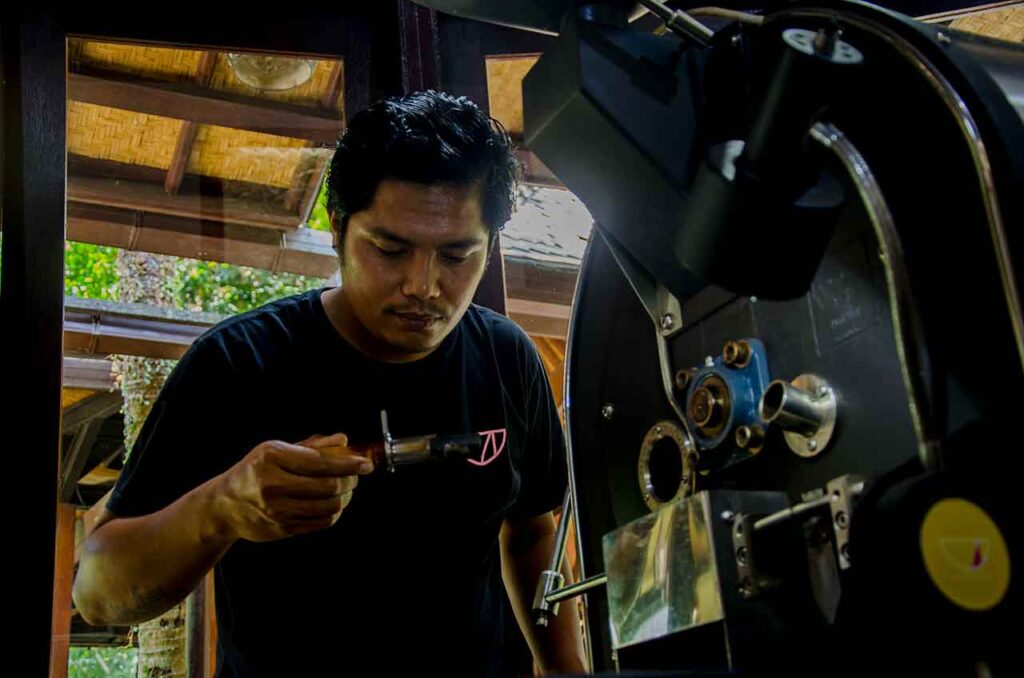
Gus Adi Kopi again pulled the sample spoon from the barrel. Then pushed the coffee beans, which were starting to look darker, under the spotlight. He wanted to more clearly check the darkness level of his roasting results. He put the sample spoon back into the barrel. His fingers quickly adjusted the buttons and knobs on the control panel.
“In the past, I was only taught how to turn on and turn off the roasting machine,” he recalled, telling of the beginning of learning the roaster profession.
After approximately 6 months of working as a beverage serving officer, he was trusted to be responsible for the coffee outlet that had just opened on Jl. Gautama, one of the tourist crowd area in the center of Ubud.
Then he was trusted to be an assistant roaster who then became his mentor in getting to know coffee more deeply. He can’t forget Mr. Rosyad, a photographer, computer programmer, and someone who also really understands coffee. From Mr. Rosyad, he didn’t learn directly about the details of coffee, but about how to study correctly and effectively.
“Once I wasn’t greeted all day, because I didn’t want to go to the coffee plantation on my day off from work,” he said, remembering how his mentor disappointed him, because Gus Adi seems to be trivializing one of the series of coffee production processes.
Since then, Gus Adi began to realize how Mr. Rosyad showed that if you want to learn about coffee, it would be good to understand the process chain from upstream to downstream, not just in front of the roasting machine.
The coffee activist community has also become a learning space for Gus Adi. He learned a lot about coffee from those who were more senior in this field.
Mr. Ainun Nabiel, who opened the Ubud Coffee Culture coffee shop in the Tebesaya, Ubud area, is a coffee activist who often shares his knowledge and insights about coffee.
“Mr. Nabiel made me realize that learning about coffee seems to never end,” he said.
If you just change coffee from green beans to roasted beans, there is already a machine. We will follow the steps and we will definitely be able to do it. But, it turns out coffee is not that simple.
Studying coffee is very complex, from seeding, planting, the nutrients in the plantation soil, rainfall, harvest patterns, post-harvest processing methods, to the end when coffee is brewed.
“I learned a lot from Mr. Nabiel about all of that,” he said.
Dare to keep trying and learning from mistakes is a method that Gus Adi continues to practice. The more we understand the flow of coffee as a whole, the more we can understand how to roast coffee beans for maximum results.
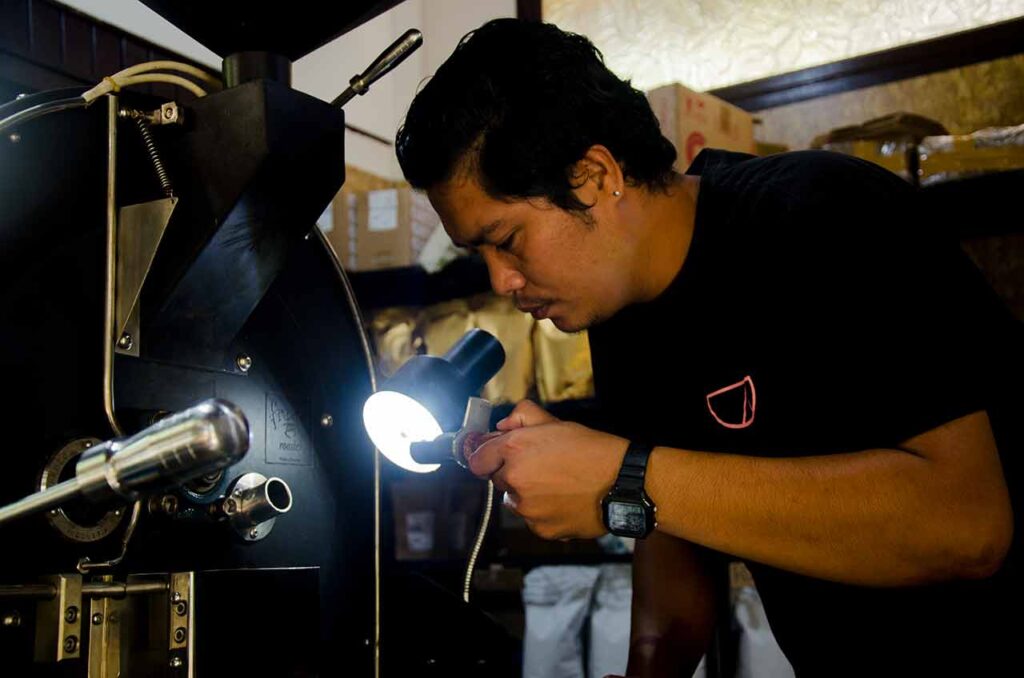
“I sometimes chat with the coffee beans, as if they were talking to me, telling me what to do with these coffee beans to produce maximum roasting,” he said chuckling.
It’s not surprising that Gus Adi’s roast is one of the choices of coffee lovers in Ubud, Bali. His ability to “communicate” with the coffee beans, even though this is like a form of imaginary conversation, but the consistency of the roasting results proves that he roasts using intuition. Astuteness is formed due to long experience and internalized knowledge.
Gus Adi Kopi is like a coffee bean whisperer because of his ability to understand the character of coffee beans and his expertise in maintaining and bringing out the results of his roasting. Because he always heard the whisper of the coffee beans he was roasting.
Follow Gus Adi Kopi at Instagram @gus_adi_ucr76

